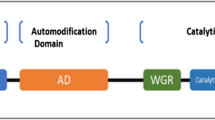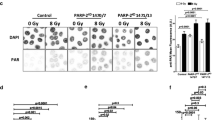Abstract
An accurate and sensitive detection of catalytic activation of poly(ADP-ribose) polymerase-1 (PARP-1) is required to be performed in a wide variety of samples because this activity plays a role in various cellular responses to DNA damage ranging from DNA repair to cell death, as well as in housekeeping functions, such as transcription. Since PARP-1 gene is expressed constitutively, its activation cannot be surmised from increased expression of its mRNA or protein, but by demonstrating the consequences of its catalytic reaction which results in consumption of the substrate nicotinamide adenine dinucleotide (NAD+) and formation of three products, namely, polymer of ADP-ribose (pADPr or PAR), nicotinamide, and protons. Here, we describe various approaches commonly used in our laboratory for detection of PARP-1 activation in vivo (cells, tissues, and tumors), in situ, and in vitro via assessment of formation of pADPr, depletion of the substrate NAD, or formation of protons resulting in rapid and reversible intracellular acidification. It is important to note that although some other members of the PARP family can carry out the same catalytic reaction, many of these assays largely reflect PARP-1 activation in a vast majority of the experimental circumstances and more specifically in DNA damage responses. However, if required, PARP-1-specific action should be confirmed by use of PARP-1 knockout or RNAi-mediated knockdown approaches.
Access this chapter
Tax calculation will be finalised at checkout
Purchases are for personal use only
Similar content being viewed by others
References
Affar EB, Shah RG, Dallaire A-K, Castonguay V, Shah GM (2002) Role of poly(ADP-ribose) polymerase in rapid intracellular acidification induced by alkylating DNA damage. Proc Natl Acad Sci USA 99:245–250
Amé JC, Jacobson EL, Jacobson MK (2000) ADP-ribose polymer metabolism. In: de Murcia G, Shall S (eds) From DNA damage and stress signalling to cell death: poly ADP-ribosylation reactions. Oxford University Press, New York, pp 1–34
Rouleau M, Patel A, Hendzel MJ, Kaufmann SH, Poirier GG (2010) PARP inhibition: PARP1 and beyond. Nat Rev Cancer 10:293–301
Shah RG, Ghodgaonkar MM, Affar EB, Shah GM (2005) DNA vector-based RNAi approach for stable depletion of poly(ADP-ribose) polymerase-1. Biochem Biophys Res Commun 331:167–174
Ghodgaonkar MM, Zacal NJ, Kassam SN, Rainbow AJ, Shah GM (2008) Depletion of poly(ADP-ribose)polymerase-1 reduces host cell reactivation for UV-treated adenovirus in human dermal fibroblasts. DNA Repair (Amst) 7:617–632
Hopfner M, Sutter AP, Beck NI, Barthel B, Maaser K, Jockers-Scherubl MC, Zeitz M, Scherubl H (2002) Meta-iodobenzylguanidine induces growth inhibition and apoptosis of neuroendocrine gastrointestinal tumor cells. Int J Cancer 101:210–216
Vodenicharov MD, Ghodgaonkar MM, Halappanavar SS, Shah RG, Shah GM (2005) Mechanism of early biphasic activation of poly(ADP-ribose) polymerase-1 in response to ultraviolet B radiation. J Cell Sci 118:589–599
Kawamitsu H, Hoshino H, Okada H, Miwa M, Momoi H, Sugimura T (1984) Monoclonal antibodies to poly(adenosine diphosphate ribose) recognize different structures. Biochemistry 23:3771–3777
Shah GM, Poirier D, Duchaine C, Brochu G, Desnoyers S, Lagueux J, Verreault A, Hoflack JC, Kirkland JB, Poirier GG (1995) Methods for biochemical study of poly(ADP-ribose) metabolism in vitro and in vivo. Anal Biochem 227:1–13
Halappanavar SS, Le Rhun Y, Mounir S, Martins M, Huot J, Earnshaw WC, Shah GM (1999) Survival and proliferation of cells expressing caspase-uncleavable poly(ADP-ribose) polymerase in response to death-inducing DNA damage by an alkylating agent. J Biol Chem 274:37097–37104
Scovassi AI, Mariani C, Negroni M, Negri C, Bertazzoni U (1993) ADP-ribosylation of nonhistone proteins in HeLa cells: modification of DNA topoisomerase II. Exp Cell Res 206:177–181
Pieper AA, Brat DJ, Krug DK, Watkins CC, Gupta A, Blackshaw S, Verma A, Wang ZQ, Snyder SH (1999) Poly(ADP-ribose) polymerase-deficient mice are protected from streptozotocin-induced diabetes. Proc Natl Acad Sci USA 96:3059–3064
Bakondi E, Bai P, Szabo EE, Hunyadi J, Gergely P, Szabo C, Virag L (2002) Detection of poly(ADP-ribose) polymerase activation in oxidatively stressed cells and tissues using biotinylated NAD substrate. J Histochem Cytochem 50:91–98
Zhou Y, Liang S, Williams LR (2002) Markers of poly (ADP-ribose) polymerase activity as correlates of DNA damage. Methods Mol Biol 203:247–255
Shah GM, Shah RG, Veillette H, Kirkland JB, Pasieka JL, Warner RRP (2005) Biochemical assessment of niacin deficiency among carcinoid cancer patients. Am J Gastroenterol 100:2307–2314
Alvarez-Gonzalez R, Jacobson MK (1987) Characterization of polymers of adenosine diphosphate ribose generated in vitro and in vivo. Biochemistry 26:3218–3224
Jacobson MK, Payne DM, Alvarez-Gonzalez R, Juarez-Salinas H, Sims JL, Jacobson EL (1984) Determination of in vivo levels of polymeric and monomeric ADP-ribose by fluorescence methods. Methods Enzymol 106:483–494
Shah GM, Kaufmann SH, Poirier GG (1995) Detection of poly(ADP-ribose) polymerase and its apoptosis-specific fragment by a nonisotopic activity-Western blot technique. Anal Biochem 232:251–254
Simonin F, Briand JP, Muller S, de Murcia G (1991) Detection of poly(ADP-ribose) polymerase in crude extracts by activity-blot. Anal Biochem 195:226–231
Sambrooke J, Russel DW (2001) Molecular cloning: a laboratory manual, Vol. 3, 3rd edn. Cold Sprong Harbor Laboratory Press, New York
Acknowledgments
We thank M. Miwa (Japan) for the permission to obtain the 10H hybridoma clone from Riken BRC Cell Bank. The writing of this review and some of the experimental work was supported by an operating grant to GMS from the Natural Sciences and Engineering Research Council of Canada (155257-06). Some of the experimental work described here was supported by the operating grants to GMS from the Canadian Institutes of Health Research (MOP-89964) and the Canadian Cancer Society Research Institute (NCIC-16407). GMS was partially supported by the FRSQ-senior research scientist award, and FKK was recipient of the doctoral scholarship award from the Natural Sciences and Engineering Research Council of Canada.
Author information
Authors and Affiliations
Editor information
Editors and Affiliations
Rights and permissions
Copyright information
© 2011 Springer Science+Business Media, LLC
About this protocol
Cite this protocol
Shah, G.M. et al. (2011). Approaches to Detect PARP-1 Activation In Vivo, In Situ, and In Vitro. In: Tulin, A. (eds) Poly(ADP-ribose) Polymerase. Methods in Molecular Biology, vol 780. Humana Press, Totowa, NJ. https://doi.org/10.1007/978-1-61779-270-0_1
Download citation
DOI: https://doi.org/10.1007/978-1-61779-270-0_1
Published:
Publisher Name: Humana Press, Totowa, NJ
Print ISBN: 978-1-61779-269-4
Online ISBN: 978-1-61779-270-0
eBook Packages: Springer Protocols




